Description
KORG MW 2408 MIXER MIXER
| Settings | Korg Mw 2408 Mixer Mixer remove | Neve 8816 Summing Mixer remove | Dangerous Music LIAISON Analog Master Router remove | Heritage Audio MCM-20.4 20-channel Summing Mixer remove | Avid S1 eight-fader EUCON control surface remove | Midas PRO2C remove |
|---|---|---|---|---|---|---|
| Image | 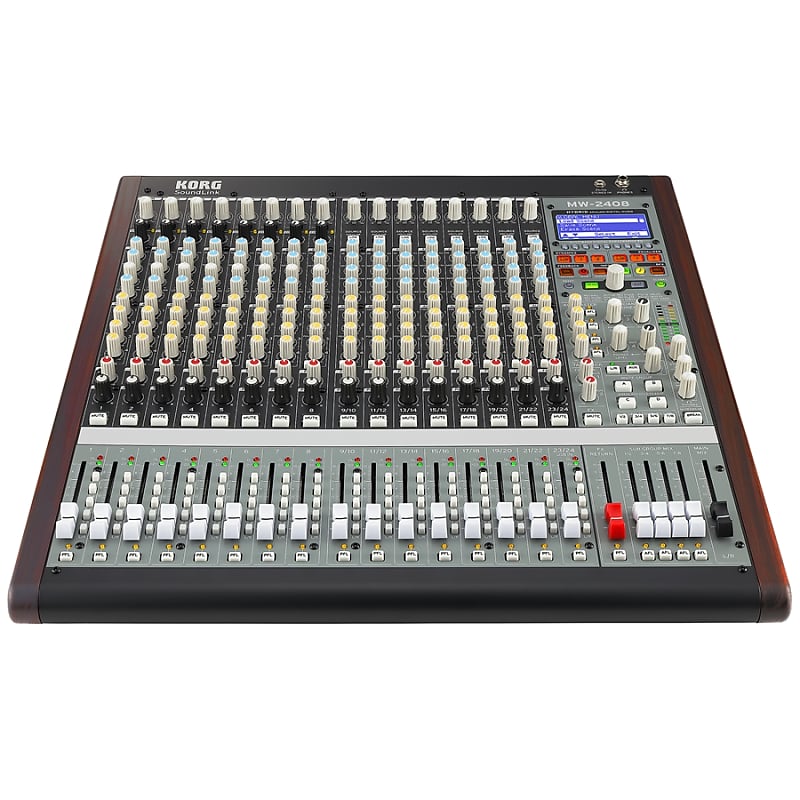 |  |  | 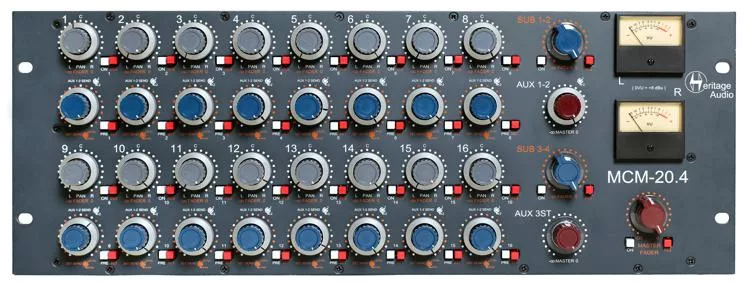 | 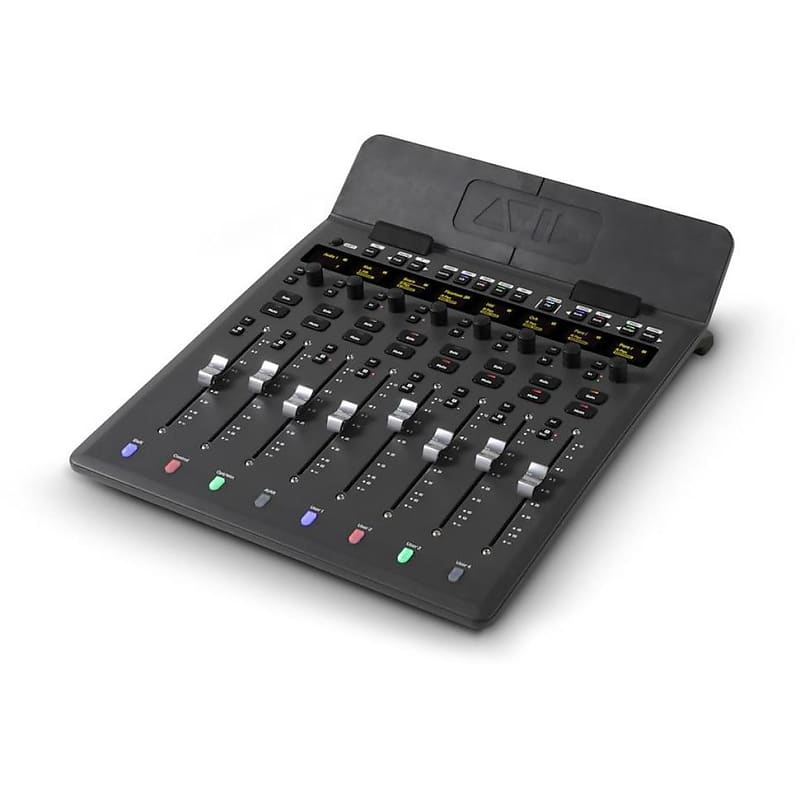 |  |
| SKU | 4959112191150 | 5060834530055 | 628586497030 | 702877907221 | 724643121884 | 736211842671 |
| Rating | ||||||
| Price | $1,121.14 | $2,297.75 | $2,120.29 | $2,827.29 | $911.13 | $7,325.90 |
| Stock | ||||||
| Availability | ||||||
| Add to cart | ||||||
| Description | ||||||
| Content | KORG MW 2408 MIXER MIXER | If you're seeking to take your projects to a level on par with world-class analog consoles, the AMS Neve 8816 will lead you to new sonic frontiers and beyond. The 8816's handbuilt, handwired 16-channel mixer employs the same transformer-balanced mix bus circuitry as a '70s-era Neve 80-series console, infusing every signal that flows through it with increased headroom, punch, and dimensionality. The 8816 does more than mere analog summing, however. This feature-laden box also includes cue mixing, metering, per-channel solo/mute, and talkback functionality. Its capable monitoring section includes a volume knob, an auxiliary input, dual headphone outputs, and alternate speaker outputs. Beyond that, the 8816 includes a main stereo insert send/return for strapping a compressor, EQ, or other processing across your entire mix, while its unique Width knob gives you a level of control over your mix’s stereo field that’s generally reserved for top-level mastering facilities. Craving tactile, hands-on control over your mix? Add an 8804 Fader Pack (sold separately). The 8816 also includes a USB port for saving and recalling settings to and from your computer, plus a digital I/O option, which provides you with A/D conversion (option card sold separately).
Inject your projects with the unmistakable Neve soundVintage Neve 80-series consoles are simply legendary. Watch Dave Grohl’s Sound City documentary for definitive proof, or listen to any of the countless chart-topping recordings that were made with one. Elton John, Steely Dan, Nirvana, Pink Floyd, Dire Straits, George Clinton, Chick Corea, Grateful Dead, REO Speedwagon, Cheap Trick, Foreigner, Tom Petty and the Heartbreakers, Pat Benatar, Santana, Ratt, Rage Against the Machine, Tool, Slayer, Kings of Leon, Slipknot, Elvis Costello, Everclear, Mastodon, and many other artists were recorded or mixed on a Neve 80-series console. The AMS Neve 8816 contains genuine 80-series topology, boasting two custom Neve Marinair specification transformers on its stereo mix bus. Whether you use it for tracking and overdubbing, submixing and summing, or mastering, the 8816 will infuse your projects with the authoritative sound of a classic Neve console. All the sonic hallmarks are present: the heft, the muscle, the three-dimensional non-linearities — enabling you to add color and vibrancy to every project.  16 feature-packed channels of classic Neve characterThe AMS Neve 8816 is centered around a feature-rich 16-channel analog mixer. Each channel boasts a line-level input with a rotary Level control, a rotary Pan control, a Cue button, and a Cut/Solo button. The Level knob, which accommodates both +4dBu and -10dBV sources, ranges from ∞dB to +15dB with 0dB set at approximately 12 o’clock. The Pan knob offers smooth, progressive operation with -3dB center attenuation. The Cue button sends the channel’s input, pre-fader, and pre-pan to the 8816’s cue mix. Channels 1–14 are individually switchable to the cue mix, while Channels 15–16 are stereo linked. At Sweetwater, we’ve found channels 15–16 incredibly useful for playback of a rough 2-track artist mix while overdubbing. The Cut/Solo button enables you to mute or solo a track. Since the 8816’s solo system is latching, you can also build solo groups, then use the master Cut/Solo button to audition or mute a group — a must-have feature when comping or sorting out EQ or balance problems.A full-blown Neve console in a 2U rackmount formatThe sheer number of the 8816's mix send/return options is enough to make your head spin, in a good way. Place a stereo compressor, EQ, or other processing across your entire mix, or create a parallel return for New York-style compression. Access high-end, mastering-studio-level stereo image enhancement with the Width control. Route the 8816’s 2-track return to its cue mix, or replace your headphone cue mix with the main monitor mix. The insert return and 2-track return feature independent level controls, providing you with near-endless customization. You can also put the 8816’s sends/return in Mid-Side mode. There’s even a hidden talkback mic that you can engage with a push of the 8816’s headphone level knob. With all of this complexity, you may be concerned that you’ll lose your settings. Don't worry: the 8816’s USB port allows for easy recall of your settings via control software on your Mac or PC. And if you need more inputs, you can cascade up to 32 units for up to 512 channels.  Comprehensive monitoring sectionThe AMS Neve 8816’s comprehensive monitoring section puts it at the very heart of your studio. You get four monitoring sources: the 8816’s 2-track return, channels 1/2 (pre-fader), its auxiliary input, and your main monitor mix. A Mon Level knob allows you to calibrate your mixing levels (we recommend aiming for 85dB), while a Mix Level knob controls the output level to your DAW. Main/alternate speaker outputs enable you to reference your mixes on a second set of studio monitors. The 8816’s dual headphone outputs are wired in parallel, one on the front panel and the other on the rear, where there are also balanced line outputs for feeding a separate headphone amp. You also get two quasi-PPM VU meters fed from the 8816’s main outputs, along with analog and digital clip indicator LEDs.The legend continuesAt Sweetwater, the name Neve commands reverence. Rupert Neve started designing audio equipment in the tube console era but made his mark with solid-state designs. Setting up shop in Little Shelford in the ’60s, Mr. Neve faced many obstacles establishing his brand amid a new technological landscape. Transistors were new, expensive, and difficult to obtain in quantity in the UK. Reliable faders didn’t exist yet — a far cry from today’s world, where parts are affordable and readily available from multiple suppliers, all competing to win bids. Nevertheless, Rupert persisted. And by the early 1970s, the Neve company was humming along, taking orders and building custom transformer-balanced consoles for recording and broadcast studios the world over. Neve 80-series consoles had a huge, punchy, and authoritative sound that defined the sound of ’70s rock. From London to New York to Los Angeles and beyond, top studios were installing Neve desks as fast as they could. By 1978, with the introduction of the majestic 8078 — the pinnacle of handwired analog “production” consoles — and NECAM automation system, Neve boards were the main component of the success formula for any recording studio with world-class aspirations. In the decades since, AMS Neve has innovated with groundbreaking products such as the VR, VX, and 88R series consoles. And today, the company continues to advance the state of the art with cutting-edge pro audio gear that sounds incredible and intelligently addresses the challenges of the digital age.AMS Neve 8816 Summing Mixer Features:
| The Dangerous Music Liaison puts the fun back into trying out creative combinations of gear. The Liaison also lets your setup remain absolutely flexible — just what you need if you want to survive in a market that often demands recording, mixing, and mastering services from a single studio. The Liaison's claim to fame is that it combines your favorite pieces of music gear together in various configurations, allowing you to try out new gear combinations and recall them later. But there's a lot more to the Dangerous Music Liaison than mere signal routing.
Mix, match, store, and recall all your favorite gear combinationsDangerous Music has always been dedicated to providing serious engineers with the most useful gear possible. They've upped the ante again, with the Liaison. The Liaison lets you experiment with different combinations of gear, giving you a total of six discrete 2-channel inputs and two 2-channel buses. Want to hear how that compressor sounds pre- and post-EQ? With a Liaison, you can audition various hardware combinations as easily as swapping around plug-ins in a DAW. What's more, you can store and recall your favorite setups, so you can keep that killer vocal compression chain or that thumping kick drum processing path close at hand.Flexible stereo buses give you advanced configuration optionsWhen we ran the Dangerous Music Liaison through its paces here at Sweetwater, we found that its stereo buses do more than just compare two discrete signal paths. Depending on how you configure them, these stereo buses can provide you with two completely independent, flexible signal chains, each serving as its own small routing matrix. You can also combine both buses to create a long and flexible continuous signal-processing chain, in which you can reorder entire sections of your gear setup. Even cooler, you can use the Liaison's buses to establish complex parallel signal processing — opening up limitless sonic possibilities.Mastering-grade components for unrivaled sound qualityAs is the case with all Dangerous Music products, the Liaison is made entirely from mastering-grade components, so you never have to worry about audio coloration or latency. In fact, when set to simply pass audio, professional grade testers used to measure the Liaison read as though they were plugged into themselves. Talk about quality control! Here are some of the other specifics. Both the inserts and the buses feature straight-wire, unamplified, balanced signal paths. All audio is relay-switched via top-quality, gas-filled, bifurcated contact relays — ensuring that all switching is absolutely noiseless. The rest of the Liaison's signal paths feature mastering-grade components made by THAT Corp. and Burr-Brown.What the pros are saying about the LIAISON:
Dangerous Music Liaison Features:
| The Heritage Audio MCM-20.4 is a rackmount analog summing mixer that delivers vintage-quality sonics along with sophisticated routing options to streamline your hybrid studio setup. The MCM-20.4 offers 16 input channels arranged into two subgroups of eight. Each channel features concentric pan and level controls plus a balanced insert and a mute switch. Each group has its own stereo fader and balanced insert point. Both stereo subgroups are passively summed into the master bus, which has its own balanced insert point and VU meters. Makeup gain is provided by a transformer-coupled, 1073-style Class A mic preamplifier with four transformers (two per channel). Four channels of pre/post-fader aux sends are provided: AUX 1 and 2 are mono; AUX 3 is stereo. Insert send points are always signal-present, giving them an alternative use as direct outputs for recording. Rear-panel connections are made via DB-25 connectors; except for the master bus, which has dedicated XLRs.
The best of both worldsDone up in classic RAF blue-gray livery — complete with concentric pots and Marconi knobs — the Heritage Audio MCM-20.4 gives visual hints as to the sound lurking beneath the bonnet. Flavored by four transformers, that sound is decidedly vintage British, although Heritage has taken pains to improve crosstalk and self-noise specs from those of the vintage designs. The smart-summing topology employed in the company's MCM series mixers delivers impressive headroom and low noise for a 20 channel, vintage-topology mixer. Sweetwater's advice: If you want to smoothly integrate analog gear — and robust, colorful sonics — into your DAW-based workflow, the Heritage Audio MCM-20.4 is a great-sounding, elegant solution.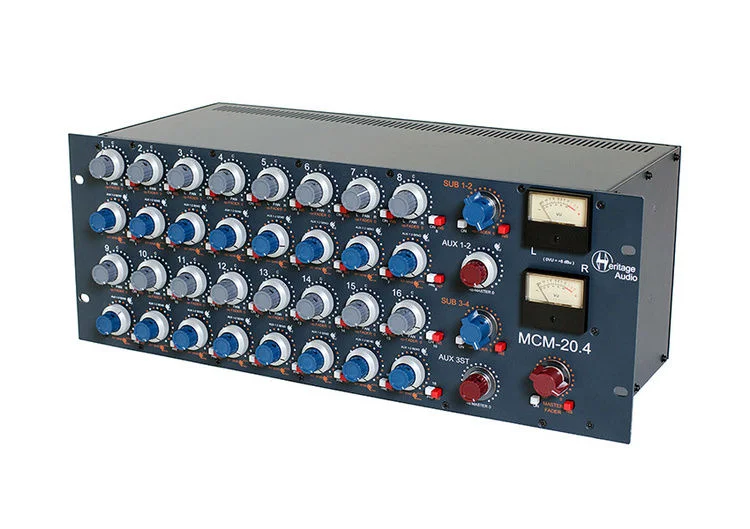 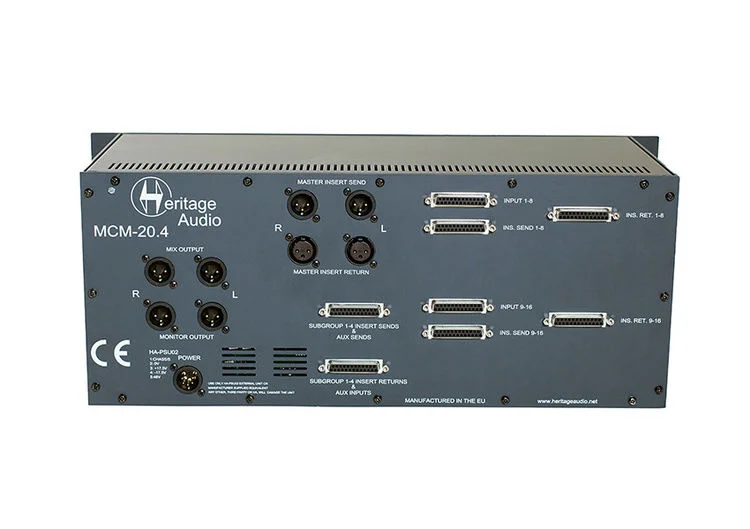 Heritage Audio MCM-20.4 20-channel, Vintage-topology Rackmount Mixer Features:
| Avid S1 eight-fader EUCON control surface
The Avid S1 is an eight-fader EUCON control surface with unparalleled speed, rich visual feedback, and software integration of Avid's high-end consoles in a slimline surface that's an easy fit for any space or budget. Avid S1 gives you deep hands-on control of your favorite audio and video software and, together with the free Pro Tools | Control app for iPad (iPad not included), provides great ergonomic efficiency, easy touch workflows, and S6-style metering and processing views, so you can navigate large sessions quickly, mix more intuitively, and turn around better sounding mixes fast.
Mix big on a smaller scale
While Avid S1 fits easily between your display and keyboard, it packs a lot of mixing power into its small surface. From motorized faders and knobs that respond to your touch, to fast-access touchscreen workflows and Soft Keys that enable you to perform complex tasks with a single press, S1 provides the speed and versatility to accelerate any music, audio post, or video project.
Get unmatched software integration
S1 is powered by EUCON, Avid’s high-speed Ethernet control protocol that delivers deep hardware/software integration, giving you full touch and tactile access to a host of Avid and third-party software functions and controls. You can even switch between multiple applications—and workstations—at the touch of a button, providing the most fluid editing and mixing experience.
Specifications:
| Midas Pro2C. Brand new, full Midas warranty. Compact Live Digital Console Control Centre with 64 Input Channels, 8 Midas Microphone Preamplifiers, 27 Mix Buses, 96 kHz Sample Rate and Touring Grade Road Case Shipping will cost extra based on buyers location. If purchased without an agreement in place, buyer will be responsible for organizing their own pickup or shipping. |
| Weight | ||||||
| Dimensions | N/A | N/A | N/A | N/A | N/A | N/A |
| Additional information |
Reviews
There are no reviews yet.